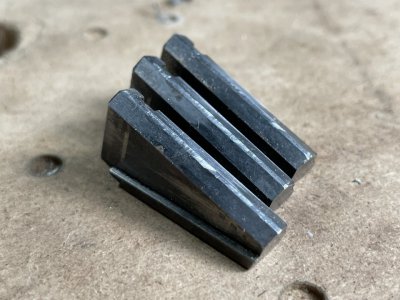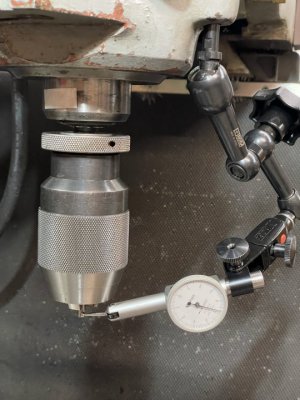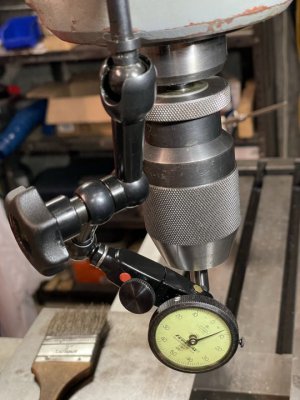A while back, I bought a used Albrecht 130 chuck, $75. It was smooth and cleaned up fine but the jaws were chewed up, leading to obvious alignment issues. Here's a picture of the jaws:

So after letting it sit for a while and looking for a set of jaws, I finally decided to buy some from McMaster, $140. I'm feeling pretty good about it and posted my new purchase after using the chuck and feeling pretty good about it. Then I measured...
I held a dowel pin in the jaws and see about 0.007" TIR. Ugh. I tried a couple dowel pins, 3/16" and 1/2" diameter. Both give about the same results. I even checked with a couple different indicators


I measured about 0.002" TIR at the back of the shell (just below the upper knurled collar in the picture). That suggests that the arbor itself is probably okay, and I measured the arbor when I initially disassembled the chuck and remember it being very good.
So now I'm questioning what to do. I see a few options:
(1) Call it good enough and just drill holes. I don't view a drill as a precision instrument and the chuck is smooth and grabs well. But it's pretty disappointing.
(2) Send to Royal, the main distributor, for rebuild or replacement; limited to $385 for a new chuck, if refurbishing this one would be more expensive than that or would not give good results. Given that I just spent $140 on jaws and don't imagine I can return them now, I obviously wish I just sent it to them in the first place. It may be the only way to get an in-spec chuck out of this. I do have another Albrecht that I could put the jaws in I guess.
(3) Disassemble again and try to figure out which additional parts need replacing. I can replace a few parts for less than sending it to Royal, but not all of them (available from Royal or McMaster). I'm not experienced enough to know what is likely the issue, but I can measure to investigate. Here's the assembly drawing:

I appreciate hearing about any experiences you may have with these or guidance how to avoid wasting more money.
-jason

So after letting it sit for a while and looking for a set of jaws, I finally decided to buy some from McMaster, $140. I'm feeling pretty good about it and posted my new purchase after using the chuck and feeling pretty good about it. Then I measured...
I held a dowel pin in the jaws and see about 0.007" TIR. Ugh. I tried a couple dowel pins, 3/16" and 1/2" diameter. Both give about the same results. I even checked with a couple different indicators


I measured about 0.002" TIR at the back of the shell (just below the upper knurled collar in the picture). That suggests that the arbor itself is probably okay, and I measured the arbor when I initially disassembled the chuck and remember it being very good.
So now I'm questioning what to do. I see a few options:
(1) Call it good enough and just drill holes. I don't view a drill as a precision instrument and the chuck is smooth and grabs well. But it's pretty disappointing.
(2) Send to Royal, the main distributor, for rebuild or replacement; limited to $385 for a new chuck, if refurbishing this one would be more expensive than that or would not give good results. Given that I just spent $140 on jaws and don't imagine I can return them now, I obviously wish I just sent it to them in the first place. It may be the only way to get an in-spec chuck out of this. I do have another Albrecht that I could put the jaws in I guess.
(3) Disassemble again and try to figure out which additional parts need replacing. I can replace a few parts for less than sending it to Royal, but not all of them (available from Royal or McMaster). I'm not experienced enough to know what is likely the issue, but I can measure to investigate. Here's the assembly drawing:

I appreciate hearing about any experiences you may have with these or guidance how to avoid wasting more money.
-jason
Last edited:


 Or , # 1 . Drill chuck is not considered a precision tool , and you already posted it completed your job on the other thread .
Or , # 1 . Drill chuck is not considered a precision tool , and you already posted it completed your job on the other thread .